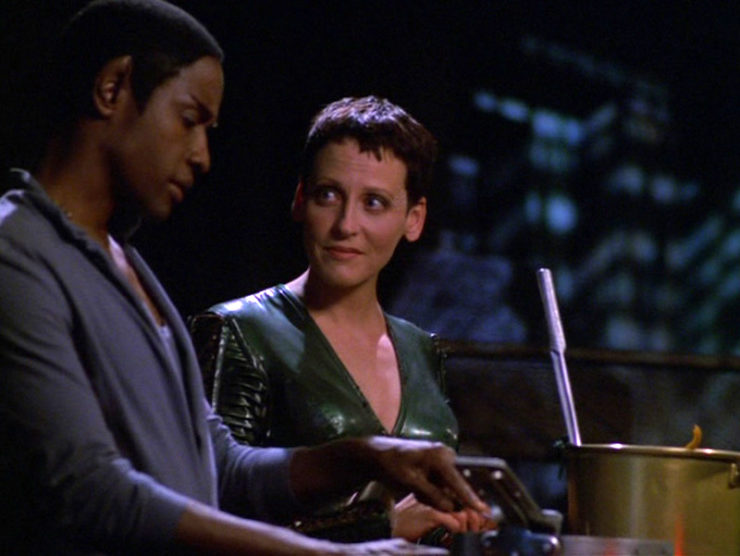“Gravity”
Written by Jimmy Diggs and Nick Sagan & Bryan Fuller
Directed by Terry Windell
Season 5, Episode 13
Production episode 205
Original air date: February 3, 1999
Stardate: 52438.9
Captain’s log. We flash back to Tuvok’s adolescence on Vulcan, where we find out that he developed a crush on an alien woman at his school, and was therefore kicked out of school and sent by his parents to see a Vulcan Master to train him in how to master his emotions.
In the present, Noss is on a Class D planet hunting for spiders to eat, using a sonic device to get them to come out from under rocks and then stabbing them. She sees a shuttlecraft crash, which we all recognize as a Voyager shuttle. She works her way over to it to find it empty. While she’s trying to salvage stuff from it, Paris shows up. She threatens him with a weapon and takes the medikit he’s carrying and some other stuff as well. As she heads back to her own crashed ship, she’s jumped by two aliens who try to take her stuff, but Tuvok arrives in the nick of time and takes them down. He brings her back to the shuttle after noting that she is already familiar with it based on the items she stole.
The combadges are on the fritz, so they can’t understand what Noss is saying. Tuvok is able to heal her bruises from being attacked, and also gives her some of their rations.
Most of the shuttle’s systems are toast. Communications is one of the few systems working, but every attempt to send a distress signal is bounced back by the distortion that they flew through before they crashed. There are more aliens en route to attack the shuttle, so they retreat to Noss’ crashed ship, which is equally unsalvageable in terms of being able to take off again, but has a force field. They grab what supplies they can, including the EMH’s mobile emitter, which was busted in the crash.
Once safely in Noss’ ship, Paris is able to repair the mobile emitter, and the EMH appears. The universal translator is part of his matrix, so he is able to communicate with Noss. She’s been on the planet for fourteen seasons, and she’s seen tons of ships crash. She’s seen none take back off.
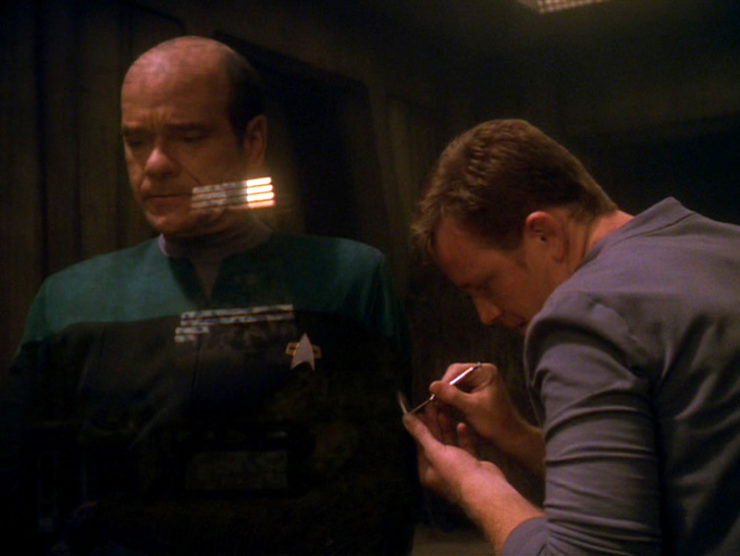
A good deal of time passes. Noss has learned English and is teaching Paris how to hunt spiders, at which he is a mediocre pupil at best. Tuvok is trying to get the shuttle’s distress beacon to get through the distortion and also informs the EMH that he will need to be switched off until needed to preserve power in case they need the mobile emitter as a power source.
Noss asks Tuvok all kinds of personal questions that she seems genuinely interested in the answer to, most of which Tuvok finds unnecessary. She asks similar questions of Paris, who is much more open. It’s obvious to Paris that Noss is falling for Tuvok, and Paris thinks he should take advantage, since they’ve been there for weeks with no sign of a rescue from Voyager—not to mention the fact that he’s unlikely to ever see his wife again even if Voyager does rescue them.
Later, Paris apologizes for insulting Tuvok, but he took no offense. Paris also says that he sees how Tuvok looks at Noss: like someone who wishes he wasn’t Vulcan.
We then flash back again to Tuvok’s youth with the Vulcan Master where he says in so many words that he wishes he wasn’t Vulcan. The Master points out that he is Vulcan, and that means that he must control his emotions, because if he does not, his emotions will control him. In the present, Tuvok also explains to Paris how incredibly turbulent Vulcan emotions are, which is why they must be kept in check, and why he cannot give in to any desire he might have for Noss.
Back on Voyager, it’s only been a couple of hours since the shuttle disappeared. They investigate, and almost get sucked into the same distortion that claimed the shuttle. The starship is able to power out of it, but now they think they know what happened. Seven and Torres are able to retune the sensors in astrometrics, and even with that, they can barely detect the distortion and what’s on the other side of it: an entire star system, including a Class-D planet.
An alien ship from the same species as the ones who jumped Noss shows up. Supervisor Yost informs Janeway that they plan to destroy the “subspace sinkhole” so no more ships are lost. Yost will give Janeway a day to try to rescue her people, but that’s all.
Voyager launches one of their fancy-shmancy multispatial probes, which determines that the shuttle’s distress beacon is present and active, there are plenty of life signs on the planet, but time moves more quickly within the distortion—the away team has been there subjectively for weeks, possibly months—and the whole system will eventually be crushed by the subspace distortion.
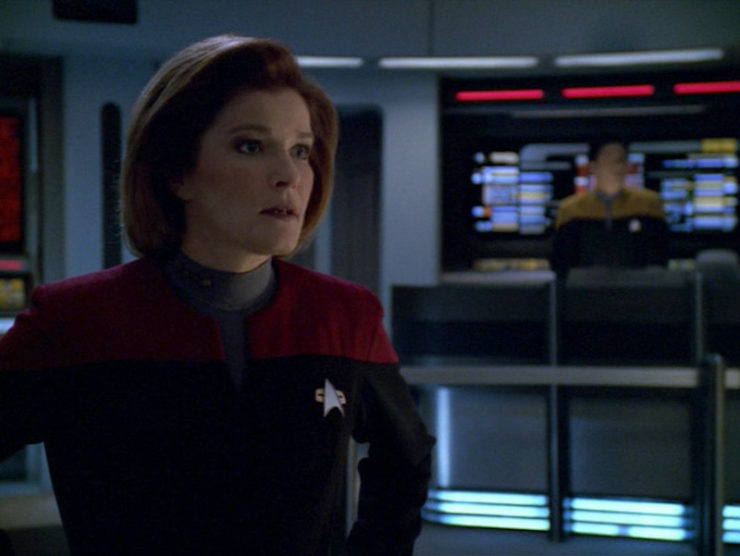
On the planet, Paris and Tuvok return to Noss’ ship, having been attacked by aliens. Tuvok is very badly injured, and the EMH is reactivated for the first time in two months in order to treat Tuvok. Noss tries to kiss Tuvok at one point, and he rebuffs her. She leaves angrily, cursing him in her own language and being pissed off about logic.
Some days later, Tuvok is meditating, and Paris interrupts him to berate him for at least not letting Noss down easy. Tuvok tells Paris about his infatuation with the alien woman as a teenager that led to his being sent to the Vulcan Master.
Buy the Book
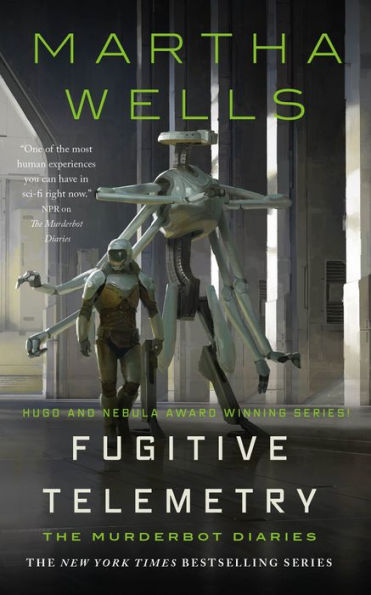

Fugitive Telemetry
Torres and Seven are able to modify the probe to serve both as a communications buoy and a transporter booster. They communicate what’s happening to the distress beacon and then make the adjustments to probe so they can use it to beam out whatever’s within two meters of the distress beacon. Their timetable is abbreviated, as Yost has started the collapse of the sinkhole sooner than expected.
The away team receives the message—which Paris has to speed up so they can understand it—which includes the relative time ratios. Janeway says they’ll beam them out in thirty minutes, and Tuvok calculates the time from when the message started to when half an hour will be for Voyager: about two days. The problem is, a bunch of aliens are ganging up on Noss’ ship and tossing photon grenades at them. They just have to hold out for forty-eight hours or so.
After two days, the force field is starting to fail. Noss has to go out and repair it. Tuvok offers to assist, but Noss tartly points out that it’s illogical to risk two lives.
The force field falls, and Noss is attacked by two aliens, who are about to kill her, but then Tuvok shows up and shoots them. He tells her that they would never leave her behind.
Inside, another alien has entered the ship is and grappling with Paris, but then Tuvok shoots him, too. Voyager initiates transport, and they’re all rescued.
Voyager brings Noss to her homeworld. Before she beams down, Tuvok and she share a mind-meld, which leaves Noss smiling happily.
Can’t we just reverse the polarity? The multispatial probe was first seen in “Extreme Risk,” and was developed by the Voyager crew in part using Borg tech. It can apparently do all kinds of nifty things that are required by the plot.
Mr. Vulcan. Tuvok gets to do to Noss what Spock did to Leila Kalomi. It’s hell being a sexy Vulcan…
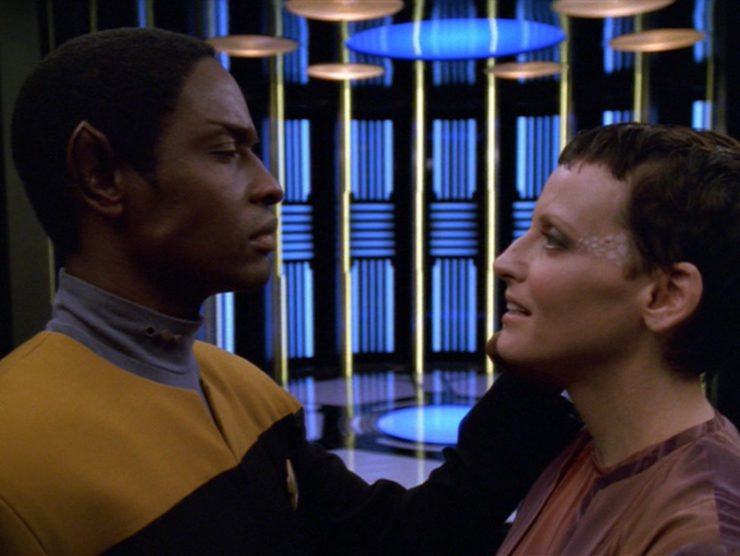
Half and half. Torres gets to do all kinds of technobabble, working with Seven to adjust the sensors to detect the sinkhole and adjust the probe to be a communications booster and a transporter booster. Because she’s just that awesome.
Forever an ensign. When Supervisor Yost first encounters Voyager, he puts the ship in a tractor beam to keep them from falling into the distortion. Kim is in charge of the bridge (Janeway and Chakotay are in astrometrics), and he tries really hard to convince Yost that they don’t need saving, and is totally ineffective in doing so.
Everybody comes to Neelix’s. Noss gives Neelix her recipe for spider, to Paris and Tuvok’s chagrin.
Please state the nature of the medical emergency. Apparently, the EMH has a universal translator built into his matrix. He also complains, “I’m a doctor, not a battery,” when informed by Tuvok that his mobile emitter might be needed as a power source.
No sex, please, we’re Starfleet. We find out that Tuvok’s first major lesson in emotional control happened because of a crush he had on a fellow teenager. Meanwhile, Paris is slightly grumpy that Torres didn’t miss him as much as he missed her, mostly because from her POV, he was only gone for two days, whereas he was away for several months, subjectively speaking.
Do it.
“You speak in riddles because the truth frightens you!”
“You’re right, it does frighten me. You are surprised to hear a Vulcan Master admit to having emotions?”
“Yes.”
“Emotions can be a powerful tool. To deny their existence is illogical. But you must learn to control them.”
“Why?”
“You wish to be taught?”
“I would question everything you say.”
“You would not be a worthy pupil otherwise.”
–Young Tuvok trying to be a rebel and a pain in the ass, and the Vulcan Master saying “Bazinga!” every time.
Welcome aboard: The late Joseph Ruskin lends his magnificent voice (and the rest of his body, natch) to the Vulcan Master. Ruskin is the only actor to have physically appeared alongside the casts of each of the first five Trek shows, having also played Galt in the original series’ “The Gamesters of Triskelion,” a Son’a in the TNG movie Insurrection, a Cardassian in DS9’s “Improbable Cause,” Tumek in DS9’s “The House of Quark” and “Looking for par’Mach in All the Wrong Places,” and (subsequently) a Suliban in Enterprise’s “Broken Bow.”
Leroy D. Brazile plays the teenaged Tuvok; he’ll play a Cardassian later in this TV season in DS9’s “The Dogs of War.” Paul S. Eckstein plays his third of six roles on either DS9 or Voyager, all covered in makeup; his other roles include two Jem’Hadar on DS9 (“Rocks and Shoals” and “The Dogs of War”), two Hirogen on Voyager (“The Killing Game” two-parter and the upcoming “Flesh and Blood”), and he’ll also play a Klingon in the seventh season’s “Prophecy.”
But the big guest is the great Lori Petty as Noss.
Trivial matters: The genesis of this episode was apparently the simple phrase “emotion creates its own logic.”
The mind-meld at the end was suggested by Tim Russ.
This is the first directorial endeavor by Terry Windell, a visual effects designer. He will go on to direct nine more Voyager episodes, as well as an Enterprise episode. Aside from a single episode of Special Unit 2 in 2001, these are his only directorial credits, having since returned to the visual effects side of things. Most recently, he was the visual effects supervisor for Amazon Prime’s The Tick.
Tuvok gives the crew complement of Voyager as 152, which is not likely to be accurate given the score-plus deaths on board. However, that may be the standard complement for an Intrepid-class ship, since Tuvok is giving the ship’s general specs when he says it.
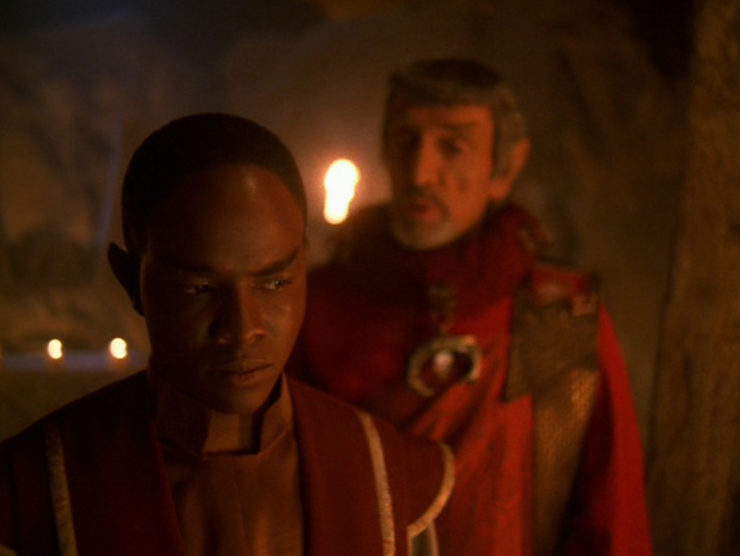
Set a course for home. “Logic! I hate logic!” There are some serious original series vibes going on in this episode, as Tuvok’s struggles with emotion, both in the flashback and in the present, as well as Noss’ struggles with falling in love with a Vulcan, are reminiscent of what we’ve seen on the flagship show, most notably “This Side of Paradise” and “All Our Yesterdays,” with a dash of “Amok Time” and “Journey to Babel” for good measure.
But it works, mainly because Tim Russ has given us the second-best portrayal of a person of Vulcan heritage to date, the best being, of course, Leonard Nimoy. Now this is mainly because Russ (like Zachary Quinto and Ethan Peck after him, in their cases both playing Nimoy’s character) is pretty much taking his acting cues from Nimoy’s performance, but there’s no shame in that.
I have mixed feelings about the flashbacks. Leroy D. Brazile does a good job of matching Russ’s inflections, albeit more emotional, obviously, and I never object to Joseph Ruskin appearing in any role, but the flashbacks don’t really accomplish anything, plot-wise. They’re well-written—I love that Tuvok keeps trying to show how he’s a rebel and he won’t be hemmed in by squares, but the Master pretty much cuts him off at the knees every single time—but their importance is summed up nicely by Tuvok when he and Paris talk on the rocks. It feels like filler in an episode that doesn’t actually have enough story for an hour.
Still, it works. Yes, the story is one we’ve seen before—not just on the original series, but also in “Alter Ego“—but the episode sings mainly because Russ, Lori Petty, Robert Duncan McNeill, and Robert Picardo all sell it. Petty is particularly good in this, giving us someone who is at once very capable of surviving on her own, but also incredibly lonely and eager for companionship. And the anguish of both sides of the doomed romance is palpable.
I was really worried when I watched this the first time that the mind-meld at the end was going to be another TOS callback: “Requiem for Methuselah,” where Spock telepathically wiped Kirk’s memory of Rayna Kapec to spare him pain. It was, therefore, a huge relief to see that Tuvok didn’t do that to Noss, but instead gave her, in essence, himself. It has been stated many times (in TNG’s “Sarek,” e.g.) that a mind-meld leaves each participant with a piece of the other in them forevermore, and that notion makes Tuvok’s parting gift to her both the sweetest and the cruelest thing he could do for both of them.
But hey, that’s love for you…
Warp factor rating: 9
Keith R.A. DeCandido did a panel on the endurance of Star Trek with fellow Trek word-slingers David Mack and Derek Tyler Attico for the Virtual Farpoint Convention last weekend. That panel has been archived on YouTube.










